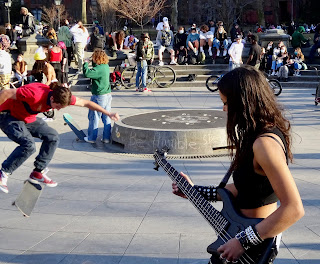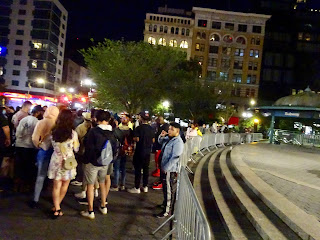As New York City reopens after lockdown, it is also closing down. During 2020, especially from spring to summer, many New Yorkers who ventured into the streets found a joyful and communal openness to the city, in the midst of so much anxiety and grief during the pandemic. In public parks, we gathered together, in mixtures of races and classes, to play music, dance, and connect politically for actions we hoped would change the world for the better. Coalitions formed. Empathy increased. Friendships were made. As spring 2021 came, this vibrant new life continued--but the city is working hard to shut it down and "get back to normal."
This repeated demand for normal always reminds me of the words from author and activist Sonya Renee Taylor: “We will not go back to normal. Normal never was. Our pre-corona existence was never normal other than we normalized greed, inequity, exhaustion, depletion, extraction, disconnection, confusion, rage, hoarding, hate, and lack. We should not long to return, my friends. We are being given the opportunity to stitch a new garment. One that fits all of humanity and nature.”
As I've biked through Manhattan, participating in protest marches, talking with many people in different areas, I've watched the suppression of open New York day after day. Not everyone is aware of the ways City Hall and the NYPD are working hard to clamp down on our public spaces, the commons that belong to all of us, along with other spaces that were transformed during lockdown into something local and liberated. And while officials claim that the crackdown is due to music, substance use, and crowding, it is clear that the police are targeting some groups and not others. While they suppress Black, brown, queer, trans, and homeless people, they apparently do nothing to stop the upper-class, young white people who have returned from their 2020 escape from New York to drink, vomit, fight, scream, blast music, and crowd the streets of gentrified neighborhoods like the East Village. Let's not pretend otherwise. Who is the city reopening for?
Much more analysis on this topic will be in my next book, "Feral City," and while I'm still busy writing that, here is a brief timeline of recent events in the spring of 2021. There is a definite pattern.
March: On sunny days, life returns to Washington Square. In the dry fountain, young people ride their skateboards, play music, and hang out. Older people sit with them and enjoy the energetic, friendly mix of races, classes, and ages. It is much like the summer of 2020, when the park was full of New Yorkers, joyfully connecting and appreciating one another.
April 8: Even though the weather is chilly, the fountain water is turned on, effectively getting rid of the culture it had been fostering. For weeks, few people approach the fountain because it’s too cold. The water, turned on early, is a device of social control. It's nothing new. Racial mixing in the Washington Square fountain has been controlled before; for example, in 1961 during the police riot against folksingers. Race and class mixing is a very dangerous combination--it leads to compassion, coalition, and movement against the ruling classes.
I speak to some of the young artists (most of whom are people of color) who have been selling their work in the park all through the pandemic. They tell me the park police have been intimidating them and giving them tickets for selling art. One artist says he feels so uncomfortable, he's thinking about leaving. (I have not seen him since.) Getting rid of people, of course, is the goal.
April 11: People play music and dance at night in Washington
Square Park, much like they did throughout the summer of 2020. After midnight,
the NYPD performs a massive raid with what look like hundreds of officers in
riot gear and on bicycle. They chase people out of the park and through the
streets around NYU. (Watch video of the raid on Instagram)
April 21: Mayor de Blasio announces a major initiative to bring tourists back to New York City. The marketing campaign has a budget of $30 million.
May 1: All of the sidewalk vendors along Canal Street and 34th Street are cleared out. Mostly Black and brown New Yorkers and immigrants, they have been here since early in lockdown 2020. One block of Canal had become so culturally inflected, it was informally named “Little Senegal.” In both locations, police officers tell me “these people are not allowed here anymore” and “It’s a new initiative.”
May 3: Governor Cuomo announces a “major reopening” for New York on May 19.
May 6: In the Village, Christopher Park is closed early and padlocked, but only on Thursdays at 4:00 or 5:00pm, just before the Stonewall Protest has its weekly rally, an event that has been going strong since July 2020. In addition, Federal Park Police are stationed with a car outside the park and they routinely go in to patrol. Parkgoers report feeling intimidated. Some leave, some relocate to Washington Square.
All through the pandemic, Christopher Park has been a haven for queer people, including many Black and brown and transgender New Yorkers, who gather here for music, dance performances, and camaraderie. The parkgoers are also of different classes, from middle-class to poor and homeless, and everyone mixes in a friendly atmosphere. More than one park-goer tells me the park closure is connected to the Stonewall Protest because local residents—perhaps people who left New York in 2020 and have now returned—have been complaining. I watch one young woman complain to the Federal Park Police that she feels “afraid” of the people in the park and suggests they are breaking the law by drinking outdoors and playing music (two things that white, upper-class people do all over town during the pandemic).
May 19: Major reopening of New York City
May 22: The NYPD performs another massive raid of Washington
Square Park, showing up again in riot gear. (Watch video on Instagram.)
May 28: After many complaints from well-organized neighbors, many of them property owners, the northwest corner of Washington Square Park is barricaded shut and drug users are pushed out. These people have been in this corner of the park for at least a year. They stayed to themselves and could be avoided, but now they move out to other sections of the park and the Village.
Same day, a 10:00 p.m. curfew begins for Washington Square Park on Friday, Saturday, and Sunday nights, two hours earlier than usual.
June 2: Parks Enforcement Police officers and NYPD launch a sting to ticket bicyclists who ride through Washington Square Park, something people have been doing without incident for the past year.
June 3: Hostile architecture is added to the circular area by the Garibaldi statue where skateboarders congregate. Large concrete planters are placed strategically to stop people from skating.
June 4: The NYPD erects a large digital traffic sign by the Washington Square Arch, spelling out the rules in light-up letters: No Skating, Bicycle Riding. No Alcohol. No Sound Devices. Dozens of police patrol the park at night, telling people to turn off any music. At 10:00 p.m., when curfew begins, cops in riot gear close the park. People leave without incident. Some go to Union Square Park, which is also closed, surrounded by police barricades.
June 5: In Tompkins Square Park, the police stop the band Pinc Louds from playing music. They shut the park down at 10:00 p.m., even though no curfew has been announced.
Activists arrive at Washington Square to protest the curfew. The police hit back violently with what look like hundreds of riot cops and SRG troops on bicycle. Parkgoers and protesters are pepper-sprayed and beaten. Once people are out of the park and the entrances are barricaded shut, the police charge, chasing people down Thompson Street, all the way to Houston Street, in a panicked stampede in which at least one person is trampled. In total, 23 people are arrested.
June 6: In Tompkins Square Park, a Queer Prom is stopped by the police and the park is shut again at 10:00 p.m
At Washington Square Park, after a negative backlash from mayoral hopefuls and other politicians, the police do not enforce the curfew. While several police vans are lined up on blocks nearby, they do not enter the park and people are free to play music and dance. It feels again like the joyful freedom of summer 2020.
June 7: A police spokesperson tells The Village Sun, “Reassessment will be made on the closing time of the park,” but Mayor de Blasio says he will keep the 10:00 curfew in place.
The latest news is that the NYPD has gone to the home of one of the June 5 Washington Square activists and put him under arrest.






















